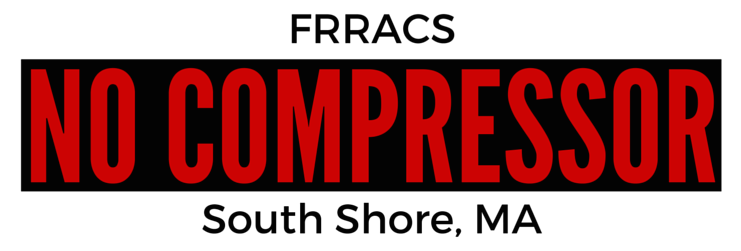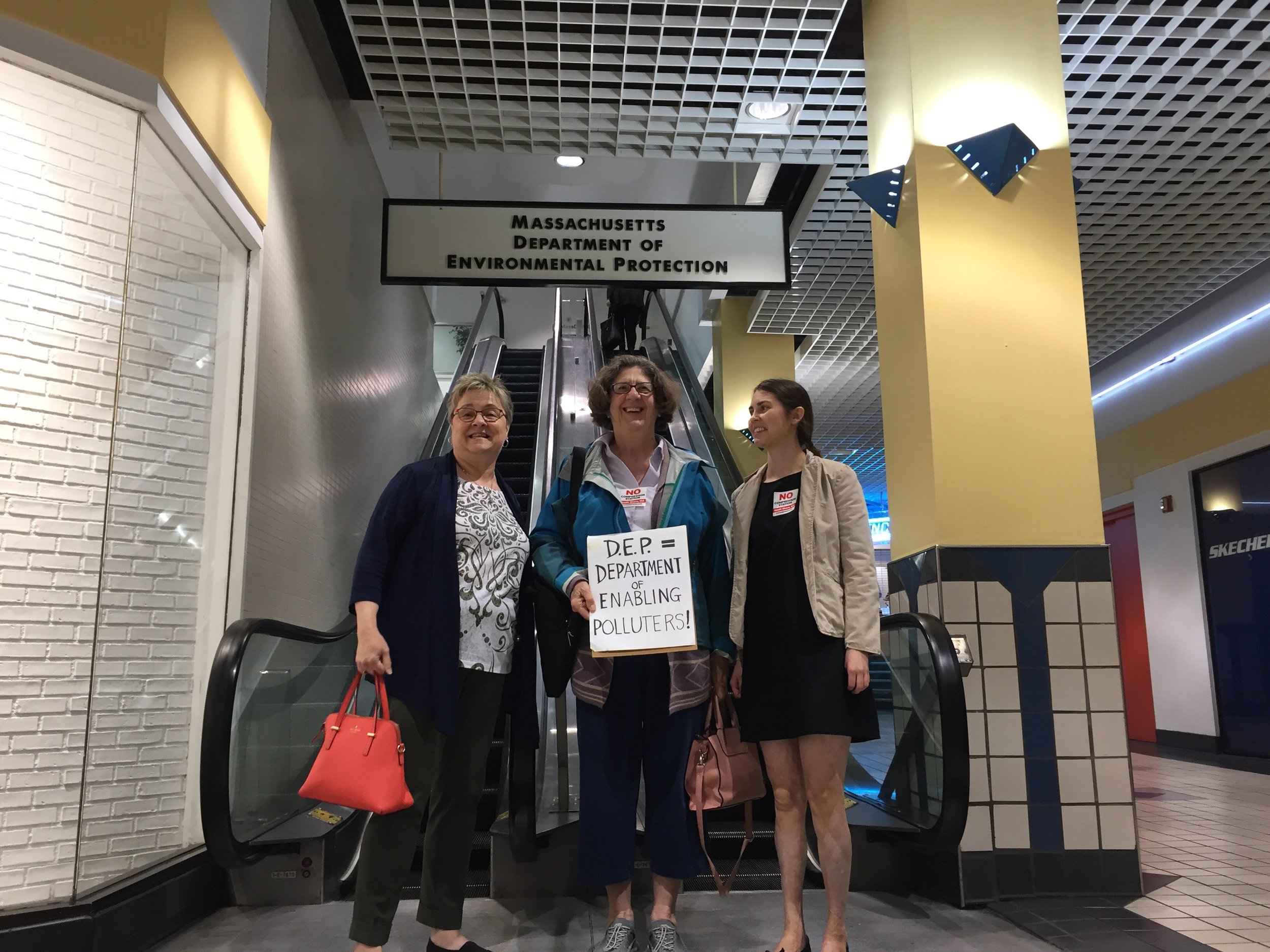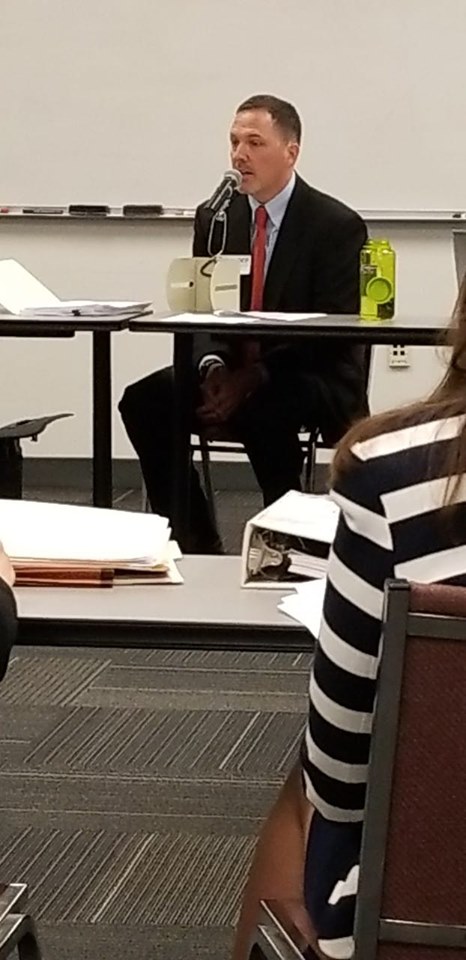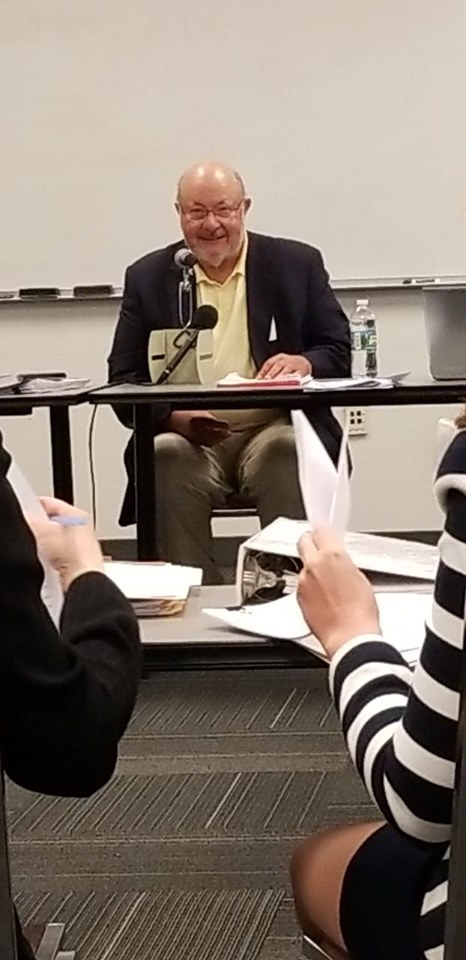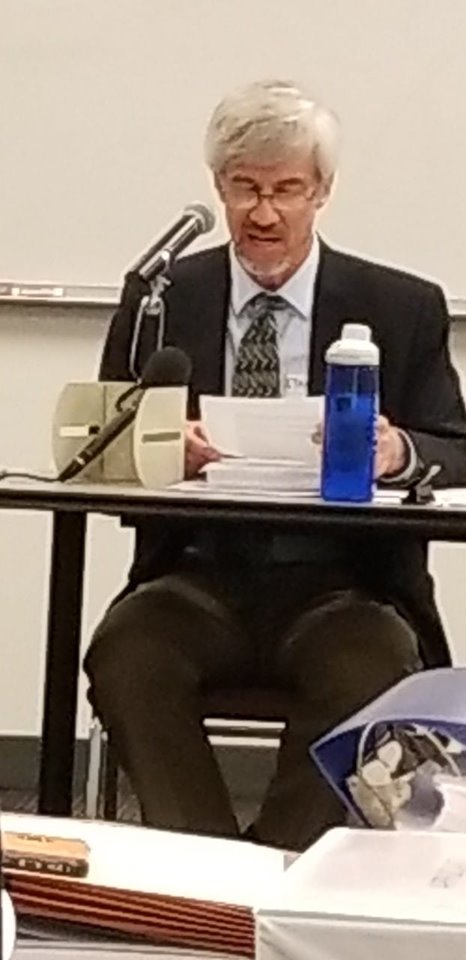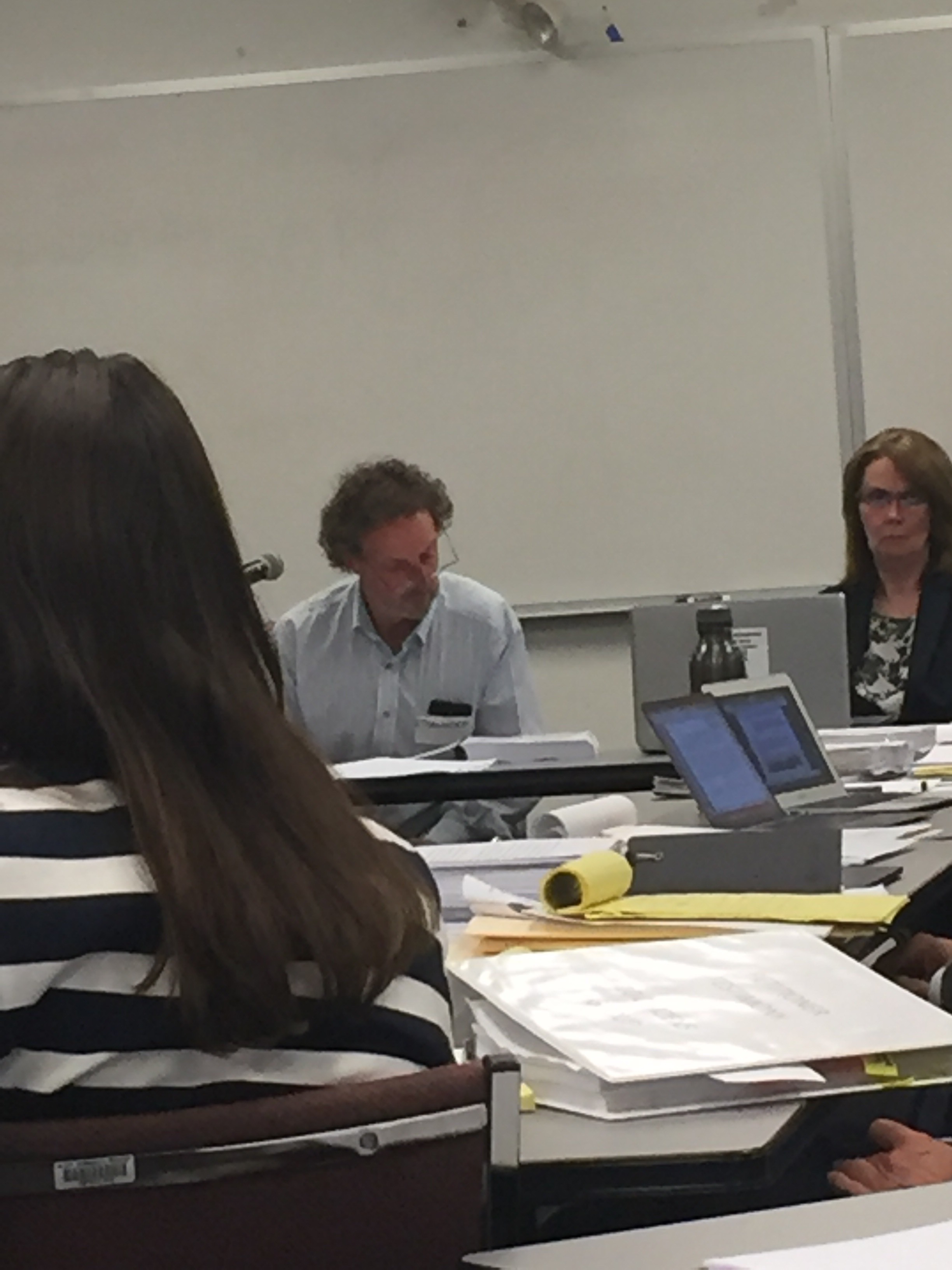Air Quality Hearing - Day 2 Recap
/We wrapped up the second day of our air quality appeal hearing day today. What a day it was! It’s amazing how exhausting these hearings can be. We finished Enbridge’s cross-examination of the petitioner’s witnesses (Weymouth, Braintree, and FRRACS) and began cross-examination of Enbridge’s witnesses. Our attorney, Michael Hayden, is really amazing. Our community is lucky to have him, and his wife, Lori Hayden, fighting on our behalf. Many thanks to both Michael and Lori.
The turnout today was smaller than yesterday but we still had a strong presence. It didn’t seem like any efforts were made to improve the sound in the room, aside from getting a stand for the one microphone.
Day 2 - Testimonies
Town of Weymouth
John Hinckley - Mr. Hinckley is an air quality and emissions modeling expert. He ran models to understand how air quality in the Basin would be impacted at different times during the day. He ran 4 different models - morning, afternoon, evening, and night. He argued that the DEP should be following their own guidelines to protect human health. One of his main arguments was that Enbridge did not include start-up emissions when calculating the amount of toxic emissions that the compressor station would produce. There are 416 start ups per year from a compressor station. Start-up emissions are 400x higher than normal operations. He also testified that the formaldehyde emissions would exceed state guidelines.
Cross-Examination by Enbridge: Enbridge attorney Nick Cram questions Mr. Hinckley on his professional background experience. He goes into detail about the places he has worked, the certifications he has received, classes he’s taken, and projects he has worked on. He talked about working with the Delaware Riverkeepers for the Indian Point Nuclear Power Plant (NY), evaluating if it would be possible to meet NY clean air requirements if alternate power was sought.
Attorney Cram tried to prove that the DEP standards (AALs and TELs) need not be followed. Mr Hinckley made a strong case that "a big slug of air pollution" from the carcinogen formaldehyde is released each time at every start up of a compressor station. This data was not included in calculating the amount of toxic emissions and it could have been. Enbridge focused very heavily on the the 416 start-ups/year and tried to argue that, in order for there to be start-ups, there are also need to be moments when the system is off, and therefore the facility is not releasing emissions. Mr. Hinckley acknowledged that while the facility needs to be off in order to be turned on, it’s not possible to measure that in the air modeling program. Enbridge was trying to make it seem like the compressor won’t be emitting as much because there will be moments when it is off, but did not acknowledge that start-ups themselves release a large amount of emissions.
You can read Mr. Hinckley’s testimony here.
Town of Braintree
Dr. Douglas Dockery - Dr. Dockery is an expert on fine particulate matter pollution and is a professor at the Harvard School of Public Health. He discussed the importance of stack height for keeping particulate matter and volatile organic compounds (VOCs) down in the coastal environment. The stack height is currently proposed to be 60 meters high and is slated to be near the MWRA intake pipe, as well as in line with traffic on the Fore River Bridge. Nothing could go wrong, right? Dr. Dockery explains that a height of 300 meters would be better. It’s important to note that stack height is irrelevant when it comes climate change impacts. The state is supposed to reach a 10% - 25% carbon emission reduction by 2020, but we are not at all close. Enbridge’s design proposal keeps changing, so it’s hard to know exactly what it will look like (i.e. turbines, stack height, etc.). And with each change, they haven’t been required to have their plans reviewed.
In response to this line of questioning from Enbridge, Dr. Dockery urged regulators to consider the potential health impacts against any potential benefits. He also brought up the important distinction between pollution exposures that we bring onto ourselves (i.e. smoking) and exposures we have no control over (i.e. pollution from industrial facilities).We already know that the compressor station will not serve any benefit to the community, given the fact that the majority of the gas will be sent to Canada for export.
The topics of plumes and seabreeze fumigation also came up during Dr. Dockery’s cross-examination. Dr. Dockery explained that a higher stack would be better at pushing the pollutants away from people, but also explained that weather and seabreezes play a role and can impact the direction in which a plume (emissions from a stack) moves. Inversion can create a “looping plume” which pushes the emissions down to the ground. Apparently, Enbridge and DEP did not use a shoreline dispersion model in their analysis.
Dr. Dockery’s testimony also made a strong case against the DEP using a policy document from 1989 for their air quality guidance. He said DEP policy was "not consistent with science" and should consider all exposures to pollution from outdoor, indoor, food, water and air. He chided the DEP as they have an opportunity to minimize harm and improve public health.
You can read Dr. Dockery’s testimony here.
Enbridge
Robert O’Neal - Mr. O’Neal is a sound expert. One of the issues with the compressor station proposal relates to sound. Compressor stations are loud (listen for yourself here) and produce ongoing sound. Mr. O’Neal reviewed modeling data in an attempt to determine how much sound the compressor station would produce.
Cross-Examination by Attorney Hayden (FRRACS): Attorney Hayden was able to get Mr. O’Neal to admit that if sound produced by the compressor station causes a nuisance, the air quality permit should not be issued (based on air quality regulations). This is a very vital point. Enbridge and DEP have tried to argue that the compressor station will not cause a sound nuisance. Mr. O’Neal wouldn’t give a straight answer as to what qualifies as a “nuisance.”
Attorney Hayden asked Mr. O’Neal if he modeled sound for the period of construction and how long construction would be. Mr O’Neal said he did not model sound during construction and does not know how long it will last, but he argues that it’s only temporary, so it doesn’t really matter.
Attorney Hayden asked Mr. O’Neal had visited a compressor station before. He said that the last time he visited a compressor station was 20 years ago in Burrillville, RI and a compressor station somewhere in the Midwest, but he doesn't remember which state it was in. When asked if he could hear sound being produced during his visit, he said yes, but said that he does not remember exactly how loud it was.
Attorney Hayden then brings up the issue of blowdowns. Blowdowns are loud. They happen at planned intervals to release pressure from the compressor station, but they can also occur unannounced as a result of an emergency. As a result of blowdowns, millions of cubic feet of methane are released into the air. Mr. O’Neal didn’t seem too concerned about the sound impact of blowdowns. We wonder if he’s heard one?
Mr. O’Neal gets into the definition of sound power and the measurement of decibels. There was some funky math going on that was hard to follow. The Presiding Officer had to ask Mr. O’Neal to explain the math to her “as if she were a child”. It still didn’t make much sense. Attorney Hayden questions Mr. O’Neal about some questionable numbers in Enbridge’s modeling.
Cross-Examination by Weymouth (Attorney Ray Miyares): Attorney Miyares questions Mr. O’Neal on series of noise regulations for the state.
You can read Mr. O’Neal’s testimony here.
Peter Valberg: Dr. Valberg is a risk assessor. He has been found to be much like a “rented white coat” (professionals and doctors who defend industry and toxic chemicals, often for money). Although he is a risk assessor, his testimony was on the DEP’s guidelines for air pollution — AALs (ambient air limits) and TELs (total exposure limits). Dr. Valberg talked about the DEP’s limits and stated that they are very strict and protective of human health. He explained that they are set as a 1 in a million risk factor.
Cross-examination by Attorney Hayden (FRRACS) - Attorney Hayden begins by asking Valberg about his previous experiences in proceedings like this one. He was questioned about his work on a case related to mesothelioma. He was contacted by a law firm and asked to collaborate on scientific literature to connect mesothelioma with smoking, even though it was widely known at the time that mesothelioma was caused by asbestos exposure. Mr. Valberg then published an article in the Journal of Environmental Radioactivity with financial support from the same law firm that initially contacted him. He then cited that article during the case when he took the position that exposure to asbestos did not cause mesothelioma, but instead was caused by smoking. He was also a witness in a case for Philip Morris.
Valberg goes on to testify that there will “exceedingly small risk” from the compressor.
Attorney Miyares for the Town of Weymouth asked Valberg if he was being compensated for his testimony. He said that he wasn’t being paid directly, but that his company, Gradient, was being paid ~$400/ for his work on this appeal.
Womp.
You can read Dr. Valberg’s testimony here.
William Welch: Mr. Welch is a former project manager for Spectra/Enbridge. He was the project manager for the compressor station proposal but has since retired (retired in the Fall of 2018?).
Cross-Examination by Weymouth: Attorney Miyares asked Mr. Welch about compressor stations and if all of Enbridge’s facilities use natural gas for power. He said yes, 100% of their compressor stations use natural gas for power. Attorney Miyares then asked Mr. Welch about power outages and what measures Enbridge has in place to deal with outages. Mr. Welch said that an outage would have an impact on the compressor, not matter how short the outage. Despite this, he didn’t seem to know anything about power outages in North Weymouth (how frequently they have occurred).
There discussion around the timeline for the project, including Enbridge’s original plan to have the compressor station in service by November 2017. Yup. 2017. Delay, delay, delay.
Media Coverage
All of the reporters who attended the hearing yesterday returned for day 2, and they stayed for the entire day. It was great to see. You can read their updates at the links below:
WGBH - Two Days Into Weymouth Gas Compressor Hearings, Safety Of Emissions Disputed (link)
Other Coverage
The twitter-verse was very active again today. Many thanks to Andrea Honore for keeping a live tweet thread. You can access her thread (an excellent memes) here. Her thread helped outline our updates above.
